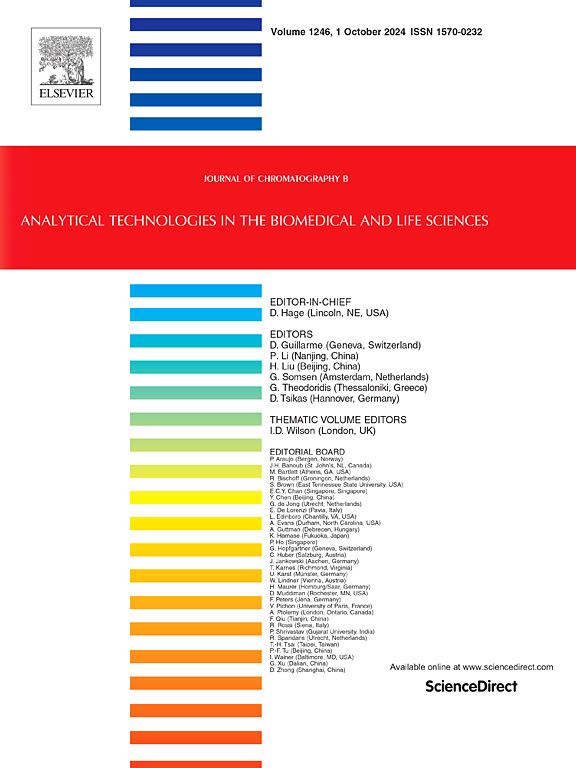利用LC-MS/MS和无标记法建立多肽质量标记,用于蟾蜍毒液的质量控制和鉴定
IF 2.8
3区 医学
Q2 BIOCHEMICAL RESEARCH METHODS
引用次数: 0
摘要
蟾蜍毒液是蟾蜍(Bufo Bufo gargarizans Cantor)腮腺分泌的一种物质,是一种传统的中药,以其强心、抗炎和抗肿瘤的特性而闻名。然而,由于蟾蜍毒液的价格不断上涨,其质量控制面临着巨大的挑战,因为蟾蜍皮和干蟾蜍等物质普遍掺假,从而损害了其真实性和治疗功效。目前还没有同时检测这些掺假物的综合方法。本研究采用纳米液相色谱-串联质谱法(Nano-LC-MS/MS)结合多元统计分析,将干蟾蜍分为皮、肉和骨,并与Bufo Bufo gargarizans Cantor的蟾蜍毒液进行比较。本研究首次提出了一种基于肽的方法来同时识别和定量蟾蜍毒液中的蟾蜍皮、蟾蜍肉和蟾蜍骨等掺杂物,为改进蟾蜍毒液的质量控制技术提供了一种有前途的方法。共鉴定出27个肽类质量标记,其中蟾蜍毒液8个,蟾蜍皮6个,蟾蜍肉5个,蟾蜍骨8个。通过生物信息学分析和高效液相色谱-三重四极杆质谱对这些标记进行了验证,从而建立了一种新颖可靠的质量控制策略。建立了利用肽质量标记NNAYDINEER测定蟾蜍毒液含量的方法。该方法特异性高,线性良好(R2 >;0.9977),定量限(LOQ)为1 ng/mL,重复性、精密度和稳定性好。对5批蟾蜍毒液样品进行分析,其含量范围为0.0387% ~ 0.0963%。本研究提供了一种创新的定性鉴定和定量测定方法,为确保蟾蜍毒液中药及相关制剂的质量和真实性提供了关键的技术和理论支持。本文章由计算机程序翻译,如有差异,请以英文原文为准。
Discovery of peptide quality markers for quality control and identification of toad venom using LC-MS/MS and label-free methods
Toad venom, a secretion from the parotoid glands of toads such as Bufo bufo gargarizans Cantor, is a traditional Chinese medicine renowned for its cardiotonic, anti-inflammatory, and antitumor properties. However, due to the rising price of toad venom, its quality control faces significant challenges from widespread adulteration with substances like toad skin and dried toads, which compromise its authenticity and therapeutic efficacy. Currently, no comprehensive method exists for the simultaneous detection of these adulterants. In this study, dried toads were subdivided into skin, flesh, and bone and compared with toad venom from Bufo bufo gargarizans Cantor using nano-liquid chromatography-tandem mass spectrometry (Nano-LC-MS/MS) combined with multivariate statistical analysis. This is the first study to propose a peptide-based method for simultaneously identifying and quantifying adulterants such as toad skin, flesh, and bone in toad venom, offering a promising approach to improve quality control techniques for toad venom. Twenty-seven peptide quality markers were identified, including eight for toad venom, six for toad skin, five for toad flesh, and eight for toad bone. These markers were validated via bioinformatics analysis and HPLC-Triple Quadrupole MS, enabling the establishment of a novel and reliable quality control strategy. A method for determining toad venom content was established using the peptide quality marker NNAYDINEER. The method demonstrated high specificity, excellent linearity (R2 > 0.9977), a limit of quantification (LOQ) of 1 ng/mL, and outstanding repeatability, precision, and stability. Analysis of five batches of toad venom samples revealed their content ranged from 0.0387 % to 0.0963 %. This study offers an innovative approach for both qualitative identification and quantitative determination, providing critical technical and theoretical support for ensuring the quality and authenticity of toad venom-based traditional medicines and related formulations.
求助全文
通过发布文献求助,成功后即可免费获取论文全文。
去求助
来源期刊

Journal of Chromatography B
医学-分析化学
CiteScore
5.60
自引率
3.30%
发文量
306
审稿时长
44 days
期刊介绍:
The Journal of Chromatography B publishes papers on developments in separation science relevant to biology and biomedical research including both fundamental advances and applications. Analytical techniques which may be considered include the various facets of chromatography, electrophoresis and related methods, affinity and immunoaffinity-based methodologies, hyphenated and other multi-dimensional techniques, and microanalytical approaches. The journal also considers articles reporting developments in sample preparation, detection techniques including mass spectrometry, and data handling and analysis.
Developments related to preparative separations for the isolation and purification of components of biological systems may be published, including chromatographic and electrophoretic methods, affinity separations, field flow fractionation and other preparative approaches.
Applications to the analysis of biological systems and samples will be considered when the analytical science contains a significant element of novelty, e.g. a new approach to the separation of a compound, novel combination of analytical techniques, or significantly improved analytical performance.
 求助内容:
求助内容: 应助结果提醒方式:
应助结果提醒方式:


